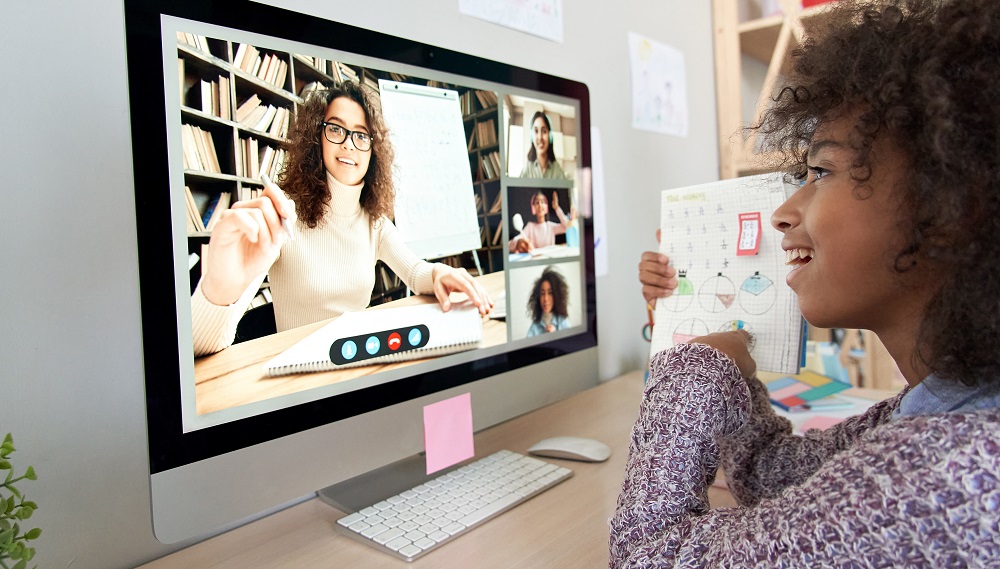When she was working for an integrator, Kim Coblentz (now at ATEN connection solutions) says schools would single out live streaming services as “unnecessary expenses.” But during COVID, these spaces had to use the technology to continue educating their students.
Making that transition wasn’t easy for many schools, according to Coblentz.
“When you introduce a bunch additional technical hardware to an existing space many small technical things need to be worked out. Streaming limits the space in which the teacher normally teaches, and I’ve heard that many accidently went outside the field of view as a result.”
Never mind the bandwidth and budgeting concerns that the switch posed.
Where integrators can help
Even after the COVID-19 pandemic is a concern, school investments in live streaming will be useful, especially in higher ed environments where hybrid learning was already normalized.
In order to best serve the education market, it’s important to know the size of the classroom and the existing AV solutions within the classroom, Coblentz says.
“Utilizing existing AV equipment and making sure it can feed into the video capture/streaming solution is key to getting the most out of a virtual classroom. Things like projectors, televisions and computers can have direct feeds into your streaming solution.”
Paul Richards, Director of Marketing for HuddleCamHD & PTZOptics, says integrators have created a few general configurations for virtual learning solutions that have proven successful.
“Two fundamental pieces of technology include a good camera and a quality microphone. Device type and placement varies depending on how much the instructor needs to move around. The microphone can be mounted directly to a table or lectern for a stationary instructor, or ceiling-mounted for a wider coverage area. It can also be worn as a lavalier microphone to clearly capture everything an instructor says.”
Similarly, camera choices range from a typical webcam clipped to the top of a monitor or laptop to a mounted static or tracking camera.
“If the class requires work shown at a whiteboard, a wall-mounted camera is ideal. Internet speed/bandwidth is important to consider as well, as slow Internet or a poor connection can really affect how the class will go,” Richards says.
What can go wrong with school live streaming services
Richards says instructors using their laptop’s built-in webcam and microphone typically results in a less-than-stellar experience.
“For the most part, laptops and computers right out of the box aren’t made for crisp quality audio and video. Some clients decline to upgrade their equipment, which can result in a poorly conducted class.
“When students aren’t able to hear and understand what their instructor is saying, they can easily fall behind on the material. At the very least, we recommend upgrading to a high-quality webcam that contains an array microphone.”
Scott Wright at Lifeline AV says he’s seen these problematic situations come up frequently:
- Poor communication with staff as to what the equipment can do. Many times this does not match the teaching styles of a teacher. Example: The school purchased lower cost USB microphones that is intended to be plug into a computer and pick up a range of a few feet but the teachers expectation is they can go to their white board and talk with everyone hearing them.
- Continuing struggles with audio. There are some good quality, lower cost, HD cameras that do pretty well in a classroom. The challenge is how do you pick up a teacher that walks throughout the classroom or pick up students engaging in a discussion, if the some of the students are in person and others on line, and have it meet the schools budget.
Opportunities for integrators
Coblentz says integrators can earn quality customers by solving two common pain points.
“Teacher-to-student interactions are rather difficult in the virtual solutions. You can’t temporarily have a conversation with a student or between students without stopping the main stream.
“Second, maintaining privacy of students homes in online sessions can be challenging, as not everyone will have a good place to set up a desk or a home that they want to share.”
Related: The 1/4 Rule and You: Why Solid State Projection is Best for Classroom Displays
It’s incumbent upon integrators to understand what type of class is being conducted. If it is a literature discussion, a teacher may not have to move around the room. They can stay in front of their screen and lead a discussion for students.
If it is a trigonometry class requiring work to be shown, then a different solution should be selected. Auto-tracking cameras and document cameras that can show content closely would be applicable here.
“Additionally, keeping students’ perspectives in mind is important,” Richards says.
“Instructors should think about what students see during lectures. Virtual class sessions can be quite successful, but an instructor must be aware of the end-user experience. I’d recommend that students mute themselves while instructors monitor chat comments in any video conferencing software to ensure questions and concerns are addressed in a timely manner.”
Classroom live streaming quick tips
Here are some things integrators need to remember for more successful live streaming technology projects:
- It’s important that integrator spend time with client really defining exactly what the needs are, the audience, defining who is running the equipment (tech-savvy IT vs. teachers/technologically lay people)
- The solution has to have an incredibly easy to use interface, even if it’s being run by someone more tech-savvy
- These projects typically need more bandwidth than you think. Providing as much bandwidth as possible will ensure a more stable solution — streaming isn’t worth a dime if it doesn’t work, so reliability is critical
- Plan an upload speed of at least 1080p/60fps
- Plan for the position of the camera — teachers are often dynamic speakers and like to move around, so make sure all cords, cameras and hardware are secured before streaming










